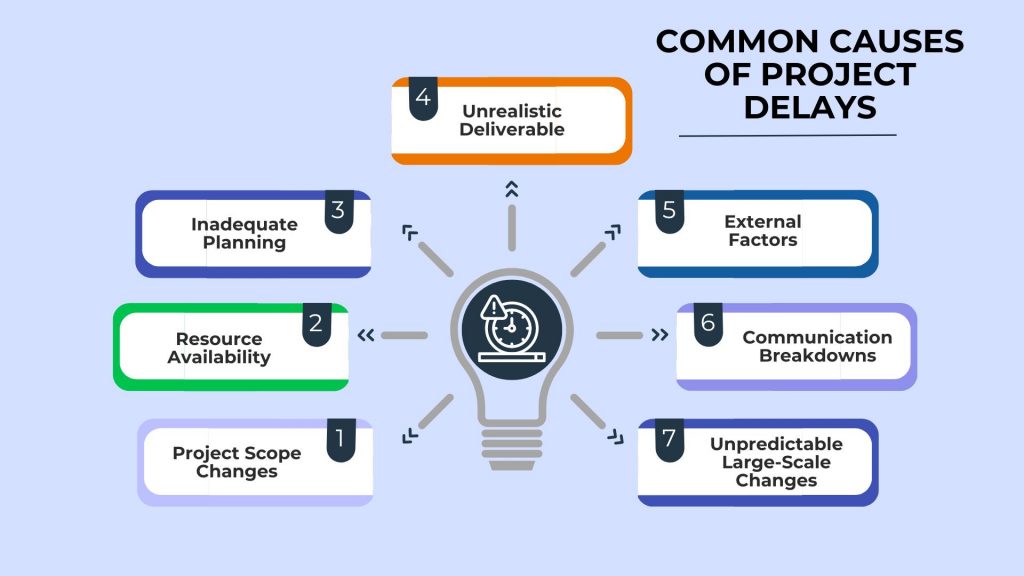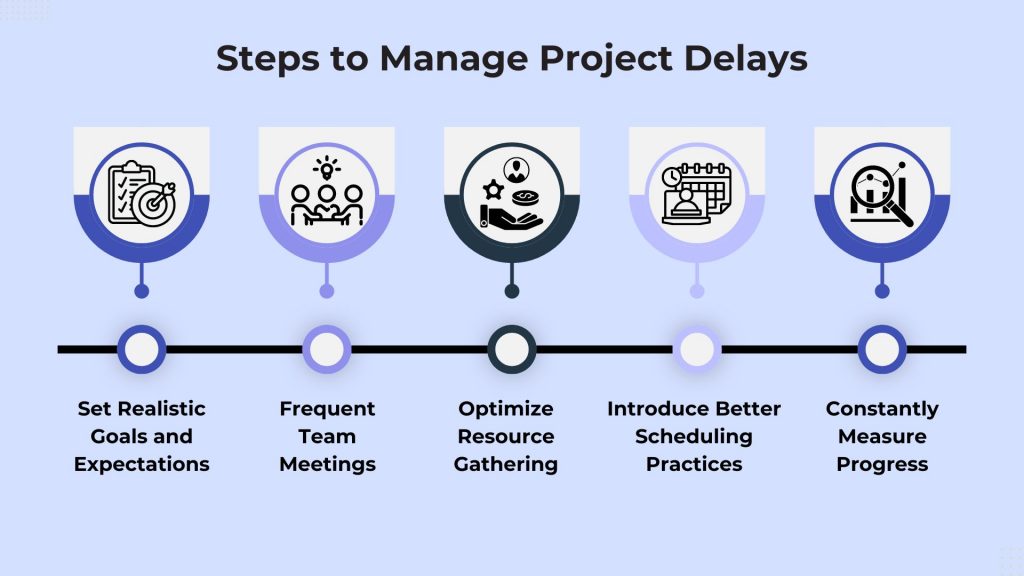
Strong project management skills keep businesses afloat. An organization’s revenue is generated by the projects that are successfully completed. According to a KPMG study, over 70% of companies today have experienced project delays and failures over the last twelve months.
The result? There is a loss of profits and proof that there is room for improvement with the existing project management practices.
Understanding where the breakdown occurs is the key indicator of where your solution needs to be applied. Carefully assess where and why the project delay occurs before equipping yourself with a remedy.
In this article, let us explore how to manage project delays in project management.
Table Of Contents:
- 7 Common Causes of Project Delays?
- What are the Impacts of Project Delays?
- 5 Effective Ways to Manage Project Delays?
- Conclusion
Project delays in project management can stem from a variety of sources, each affecting the timeline and progress of a project differently. Understanding these causes is crucial for managing and mitigating delays effectively. By identifying the root causes, project managers can implement strategies to address and prevent these issues, ensuring smoother project execution.
Watch this video on reasons behind project failure before going further on this blog
Here are some common causes of project delays, along with detailed explanations:
7 Common Causes of Project Delays?
Project Scope Changes
Project scope is defined as part of project planning. The scope outlines;
- Deliverables
- Exclusions
- Constraints
- Assumptions
These are put together to understand project requirements and client expectations. When these determining factors are changed mid-project, the effort put in to execute the project becomes void. The project has to be replanned and realigned and often restarted to meet the goals specified for successful completion.
Resource Availability
When planning for a project, the time and resource requirements are deduced early on to avoid execution concerns. However, there is no guarantee that the allocated resources will be adequate for the project. While conducting activities, mistakes may occur. Depending on the gravity of the error, resources are wasted and must be acquired again. Additionally, in situations where manufacturing machines break down, the production resource becomes unavailable, creating further problems and delays.
Inadequate Planning
Resource and time management are critical to successful project execution. Project completion is dependent on employees doing what they must at designated times. However, if the planning does not include room for error, completing a project can get complicated when timelines are skewed. Realigning timelines not only causes problems with the project being worked on but other projects in the pipeline.
Unrealistic Deliverable
Overpromising and underperforming could be more distasteful in business environments. When projects are handed over to a business, a full-scale report must be conducted to determine whether the team can realistically complete the project. If a business is unable to meet the requirements needed for the project and still take them on, delays are inevitable and unsuccessful completion.
External Factors
Suppliers are a critical part of project timelines and requirements. When suppliers delay, the production process comes to a halt until the inventory is delivered. Suppliers work in any context, not just manufacturing. Raw materials include anything that is processed to produce a finished product, including data. The delay translates down to the client who has to adjust to new project timelines.
Communication Breakdowns
Communication needs to flow easily within the organization. Multiple departments and stakeholders are involved in project completion. An effective communication breakdown can cause setbacks in processing and permissions, holding up execution and inevitably causing delays in project completion.
Unpredictable Large-Scale Changes
Often the cause for project delays and failures is not internal. When large-scale, unprecedented incidents occur like natural disasters or political issues, businesses are forced to halt their day-to-day activities. These delays cannot be avoided and must be accepted by both parties involved.
What are the Impacts of Project Delays?
A project delay never stops at the project. With a finite number of resources and staff, businesses have to make do with what is available and eventually reinvest to expand. With every day of delay, resources are going to waste, and the business incurs additional costs. If the setbacks aren’t accounted for in the planning stage, mishaps can derail the entire project.
The backlash from delayed projects is not just reflected internally. Your business reputation with customers and stakeholders could be negatively impacted, especially if the problem is persistent. If coping with the delays is too taxing, the business will have to give up the project. Now, let us see how to manage project delays.
5 Effective Ways to Manage Project Delays?
Managing project delays effectively requires a combination of effective planning, real-time monitoring, and adaptive response strategies. Effective management of delays ensures that projects stay on track and meet their objectives despite unexpected challenges. Here are several detailed steps to manage project delays:
Set Realistic Goals and Expectations
Managing expectations is critical in a business environment. Avoid setting yourself up for failure by being transparent with both your client and yourself. While setting bigger goals may be persuasive, it is more important to create a relationship of trust with your client. Set clear and realistic goals that can be tracked and measured until completion.
Ask yourself whether the resources available and the time frame given are adequate. Whether the instructions and objectives are clear, and everyone within the organization has a comprehensive understanding. Finally, be sure to work with indicators of progress that are quantifiable.
Frequent Team Meetings
The first meeting held regarding a project is always the most important. This is where roles and goals are defined and discussed. It is imperative for all employees involved to understand the role they play in project execution. Additionally, the first meeting sets milestones and timelines for the business to work with.
As time goes on, be sure to introduce team meetings regularly. This helps clarify any concerns and keep activities moving along smoothly.
Optimize Resource Gathering
A business equipped with the right resources can easily move a project from start to finish. The organization allocates a limited budget to all projects. Ensuring your project is completed within that budget is imperative to keeping the business running smoothly. Resources can include both the workforce and the physical items needed to produce the required output.
If you feel the team and resources are lacking, edit your project plan to accommodate larger budgets. Don’t forget to include costs like overheads and supplementary materials.
Introduce Better Scheduling Practices
A hard and fast timeline usually is difficult to achieve. It requires pinpoint precision with execution and minimal room for error. However, creating a comprehensive timeline with the right resource allocation and a buffer could prevent employees from feeling overwhelmed.
The schedule needs to be crisp. It must outline all the required tasks and activities, comprehensively detail the project phases, explore sequences and dependencies, and simultaneously include estimates of resources and time needed for each task. The schedule must also be readily available to all employees.
Constantly Measure Progress
As the project unfolds, ensuring employees and activities are on track keeps the project moving towards completion. Charting progress is only possible when the information relayed is maximized. These performance measures offer information critical to meeting goals and staying in line with the project plan. Transparency helps keep the team focused.
Conclusion
You can overcome project delays with new deadlines, prioritization, and communication of the same. However, the end result can often be negative for both the client and the business. Avoiding the situation in its entirety is always a better option for an organization’s reputation. Introducing firm plans and resource allocation from the get-go keeps actions streamlined. Additionally, it increases the likelihood of successfully completing a project and cementing your place within your industry. So, now you know how to manage project delays effectively.
With anything and everything being a project lately, it is high time for project practitioners globally to improve their skills by gaining knowledge in globally-recognized project management frameworks and best practices. This can be achieved by enrolling in popular Project Management Certification Courses from a registered education provider such as Invensis Learning. Start your PM journey today!



















